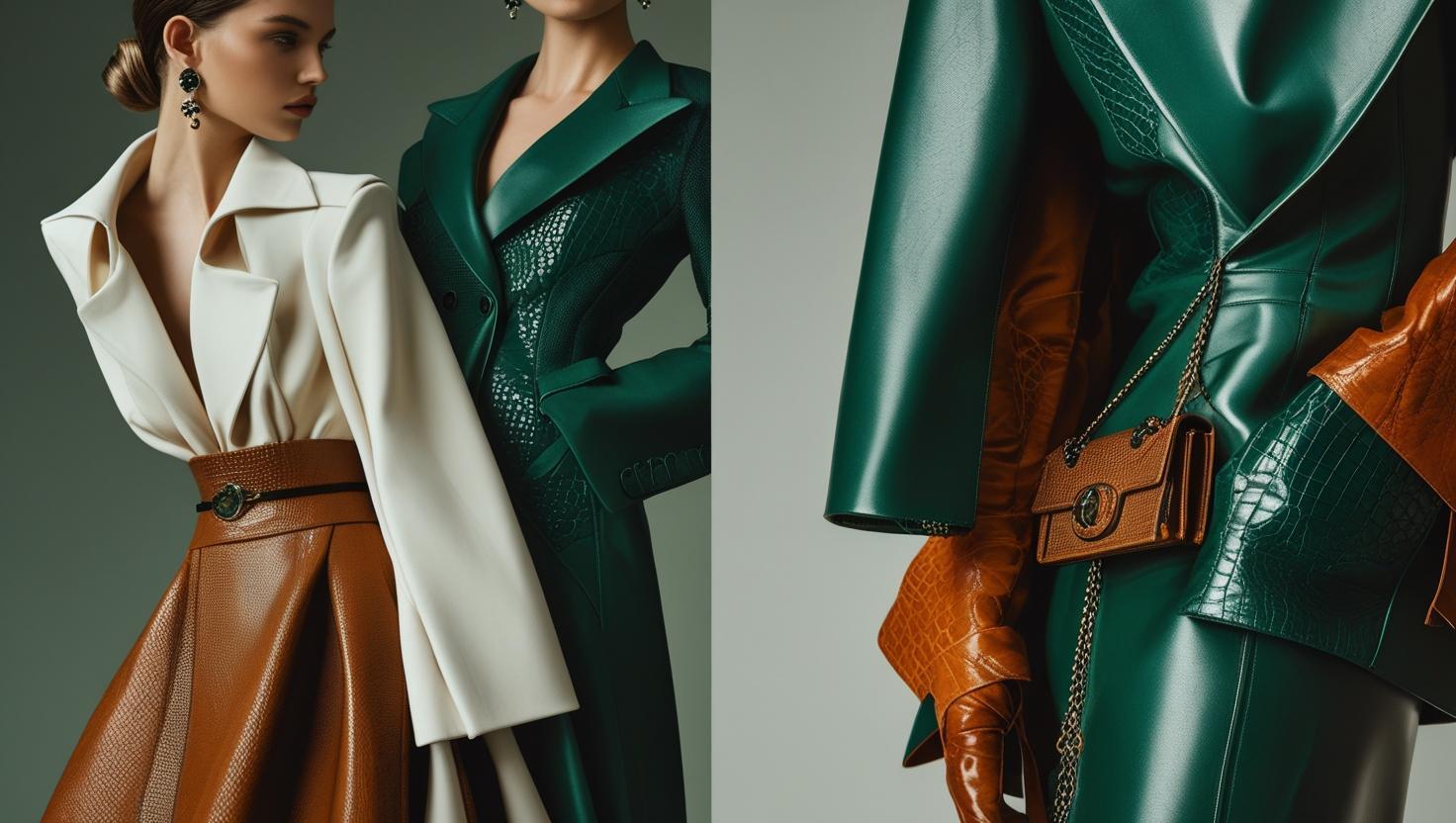22nd Jul 2025
Eco‑Leather Luxe: Next‑Gen Sustainable Leather Alternatives Take Over 2025 Runways

Over recent years, you’ve witnessed a shift as fashion pushes beyond conventional leather towards more sustainable options. While real leather remains dominant in luxury due to unmatched quality, alternatives like mushroom and pineapple leather are gaining attention. However, many substitutes rely on environmentally harmful PU materials. Innovations such as Evolved by Nature’s Activated Silk™ L1 finishing system offer a biodegradable, PFAS-free solution that enhances durability and reduces toxic chemicals, helping your fashion choices align better with sustainability goals as next-gen eco-leathers take center stage on 2025 runways.
Reinventing Luxury: The Rise of Eco-Leather
Luxury brands are redefining exclusivity through eco-leather innovations that elevate sustainability without compromising craftsmanship. By integrating bio-based finishes and cruelty-free materials, you’re invited to experience leather goods that align with your environmental values while maintaining elegance. The emergence of solutions like Activated Silk L1 finishing promises durable, stain-resistant leather with significantly reduced chemical footprints, signaling a new era where luxury embraces responsibility at scale.
The Need for Sustainable Alternatives in Fashion
As consumer expectations shift, you face mounting pressure to address the environmental impact behind your leather collections. The fashion sector’s historically high carbon emissions and toxic chemical usage demand alternatives that reduce harm and resonate with conscious buyers. Sustainable leather alternatives respond directly to this demand, offering pathways to lower your brand’s footprint while preserving the tactile and aesthetic qualities necessary to luxury goods.

Current Landscape of Vegan Leathers and Their Drawbacks
PU-based vegan leathers dominate the market but often fall short on environmental credentials due to their petroleum-derived composition and plastic content. While materials like mushroom and pineapple leather illustrate creativity, they rarely achieve the longevity, feel, or prestige required for luxury applications. You encounter obstacles such as durability issues, inferior aging characteristics, and limited scalability, which have slowed widespread adoption among premium brands.
Polyurethane (PU) remains the industry standard for vegan leather alternatives, yet its production depends heavily on fossil fuels, leading to substantial carbon emissions and microplastic pollution. Innovations like Hermès’ mushroom leather and Hugo Boss’ pineapple-leather shoes are promising but still niche, struggling to match the robust performance and luxurious finish of genuine leather. Many bio-based leathers also face challenges in consistency and large-scale production. This leaves you navigating a market where sustainable claims often clash with practical requirements, keeping real leather the go-to choice for brands that prioritize quality and legacy.
Activated Silk: A Game-Changer in Leather Finishing
Activated Silk™ introduces a transformative approach to leather finishing by harnessing upcycled natural proteins from mulberry silkworm cocoons, traditionally a waste product. This innovative system not only replaces harmful PFAS chemicals with a biodegradable, non-toxic finish but also boosts leather durability and stain resistance without sacrificing luxury quality. By integrating Activated Silk™ into your production, you gain a scalable solution aligned with tightening sustainability mandates, offering a competitive edge through cleaner processes and premium performance that resonates with environmentally conscious consumers.
The Science Behind Activated Silk Technology
This technology leverages bioactive peptides extracted via a cruelty-free process from mulberry silkworm cocoons, merging biotechnology with leather finishing. These peptides function as natural binders, creating a water- and stain-resistant finish without the need for fossil fuel-derived chemicals. You benefit from a proprietary peptide chemistry that replicates silk’s renowned strength and flexibility, ensuring your leather products maintain vital qualities such as gloss, suppleness, and longevity—all while eliminating toxic CMR solvents.

Environmental Benefits and Performance Characteristics
Activated Silk’s finishing system delivers up to 75% bio-based content and completely removes PFAS “forever chemicals,” which are linked to serious health risks. This shift reduces your product’s carbon footprint by using sustainable waste materials and biodegradable components, while stringent testing confirms resistance against eight common stains like coffee and wine. You improve end-product durability and gain certifications from eco-conscious bodies like Leaping Bunny and the Leather Working Group—key credentials for a transparent sustainability narrative.
Beyond stain resistance, the Activated Silk finish extends leather’s lifespan significantly by enhancing resistance to wear without compromising its natural feel. Using cocoon-derived peptides as a finishing agent results in a finish that biodegrades safely post-use, addressing long-term environmental impact. By eliminating CMR solvents and PFAS, you mitigate exposure to carcinogenic and persistent substances, aligning your brand with health-focused consumers and regulatory trends. As sustainability benchmarks tighten globally, this finishing method empowers supply chains, particularly in emerging markets, to produce luxury-grade leather with a notably smaller ecological footprint and superior technical properties.
Authentic Thai Leather: Bridging Tradition and Innovation
Authentic Thai Leather leverages Thailand’s rich heritage in leather craftsmanship while integrating cutting-edge biotech innovations like Evolved by Nature’s Activated Silk™ L1 finish. This fusion not only enhances the durability and sustainability of Thai leather but also provides a competitive edge by delivering products that are up to 75% bio-based and free from harmful PFAS chemicals. As you explore sustainable leather sourcing, ATL’s model presents a compelling example of how tradition can coexist with innovation, enabling access to high-quality, eco-conscious leather that meets modern luxury standards without inflating costs.
The Role of Thai Tanneries in Sustainable Fashion
Thai tanneries play a pivotal role by offering affordable, high-quality leather that aligns with growing sustainability mandates. Through partnerships with firms like Evolved by Nature, these tanneries are replacing toxic chemicals with biodegradable finishes, helping you comply with global environmental standards while maintaining leather’s hallmark flexibility and gloss. Their capacity to scale bio-based leather production positions Thai tanneries as viable alternatives to traditional European suppliers in your sustainable fashion supply chain.
Collaborations and Impact on Global Supply Chains
Collaborations between Authentic Thai Leather and biotech innovators like Evolved by Nature are reshaping global supply chain dynamics by empowering suppliers in emerging markets. You benefit from leather finished with Activated Silk™ L1 technology that combines stain resistance and durability with dramatically reduced environmental impact, all at competitive prices. This shift challenges the dominance of Western-led sustainability agendas and introduces greater supplier agency, opening pathways for diverse voices and solutions within your sourcing strategies.
Expanding on these collaborations, the partnership with ATL exemplifies how innovation accelerates sustainability without compromising on quality or cost-efficiency. By adopting the Activated Silk™ L1 system, Thai leather producers achieve a bio-based content of up to 75% and eliminate PFAS—dangerous 'forever chemicals' common in traditional leather finishing. This not only boosts your brand’s ecological credentials but also enhances resistance against eight common stains, including coffee and wine, ensuring luxury-level performance. As a result, your sourcing options broaden beyond conventional European suppliers, while supporting a more equitable and sustainable global leather market driven by shared innovation rather than hierarchical mandates.

The Future of Sustainable Luxury: Economic and Environmental Implications
Adopting next-gen leather alternatives reshapes both environmental impact and economic viability for your brand. Innovations like Evolved by Nature’s Activated Silk L1 system drastically cut carbon footprints by replacing harmful PFAS chemicals with biodegradable finishes, while enhancing durability. This reduces waste and long-term costs associated with product replacements or repairs. At the same time, aligning with stringent sustainability certifications—such as ZDHC Level 1 and Leather Working Group—positions your brand to meet evolving consumer expectations and regulatory mandates, ultimately safeguarding your market share in a landscape demanding both ethical and economic responsibility.
Market Trends Towards Eco-Friendly Practices
Consumers increasingly demand transparency and traceability in luxury fashion, with 67% of shoppers willing to pay a premium for sustainable products. Bio-based, PFAS-free leather finishes, like those from Activated Silk, answer this call by blending performance with environmental care. Major brands incorporating such technologies signal a broader shift, evidenced by runway showcases featuring sustainable leather creations. This trend drives industry-wide adoption, pressuring you to integrate similar eco-friendly practices to stay competitive and relevant amid tightening sustainability standards worldwide.
The Competitive Edge: Advantages for Brands Adopting Next-Gen Leather
Next-gen sustainable leather technologies offer your brand a multi-layered advantage: enhanced product durability, reduced exposure to toxic chemicals, and alignment with global sustainability goals. Using biofinishing systems derived from upcycled materials, such as Activated Silk’s peptides, not only elevates your environmental credentials but also opens access to new markets prioritizing ethical sourcing. Partners like Authentic Thai Leather showcase how adopting these innovations can simultaneously lower production costs and improve quality—imperative for outperforming competitors in both price and purpose-driven consumer appeal.
Expanding on these benefits, you gain a transformative opportunity to reshape your supply chain while preserving the tactile and visual qualities luxury customers expect. The Activated Silk L1 system’s proven stain resistance and natural flexibility ensure products maintain their premium aesthetic and function longer, reducing returns and boosting customer loyalty. Certifications from groups like ZDHC and the Leather Working Group further authenticate your commitment, enhancing brand reputation. This dual advantage bridges sustainability and commercial success, positioning your brand as a leader in the evolving luxury market focused on conscious consumption.

Consumer Demand and Ethical Fashion: Redefining Purchasing Power
The Shift in Consumer Preferences for Sustainability
Your purchasing decisions increasingly reflect a desire for transparency and accountability in fashion. Studies reveal that over 70% of consumers now prefer brands with sustainable practices, driving a demand for materials that reduce environmental impact without sacrificing quality. This shift pushes brands to innovate beyond traditional leather to meet your ethical standards, proving that sustainability is no longer a niche preference but a mainstream requirement shaping the future of fashion.
Brands Leading the Charge and Setting New Standards
You can witness a growing number of brands boldly adopting next-gen sustainable leather alternatives as flagship elements of their collections. Leaders like Hermès experimenting with mushroom leather and Hugo Boss introducing pineapple-leather footwear showcase how high-end names are elevating bio-based options. Meanwhile, companies partnering with Evolved by Nature leverage Activated Silk™ technology to deliver leather goods that merge luxury with measurable sustainability credentials.
Hermès’s collaboration on mushroom leather marks a pioneering step, combining natural innovation with craftsmanship revered by luxury consumers. Hugo Boss’s pineapple-leather shoes not only appeal to conscious consumers but also demonstrate scalability in bio-based alternatives. Meanwhile, brands using Activated Silk™ finishing set a new standard for durability, biodegradability, and chemical safety, backed by certifications from the Leather Working Group and ZDHC. These initiatives don’t just offer sustainable options—they actively reshape industry benchmarks, empowering you with choices that embody responsibility without compromise.
Final Words
Ultimately, you are witnessing a pivotal shift as eco-leather luxe and next-gen sustainable leather alternatives take center stage on the 2025 runways. These innovations not only enhance the quality and durability of leather goods but also align your brand with evolving consumer values and environmental responsibility. By embracing solutions like Activated Silk™ finishing systems, you have the opportunity to elevate your product offerings, reduce harmful impacts, and stay competitive in a market increasingly driven by sustainability and innovation.
